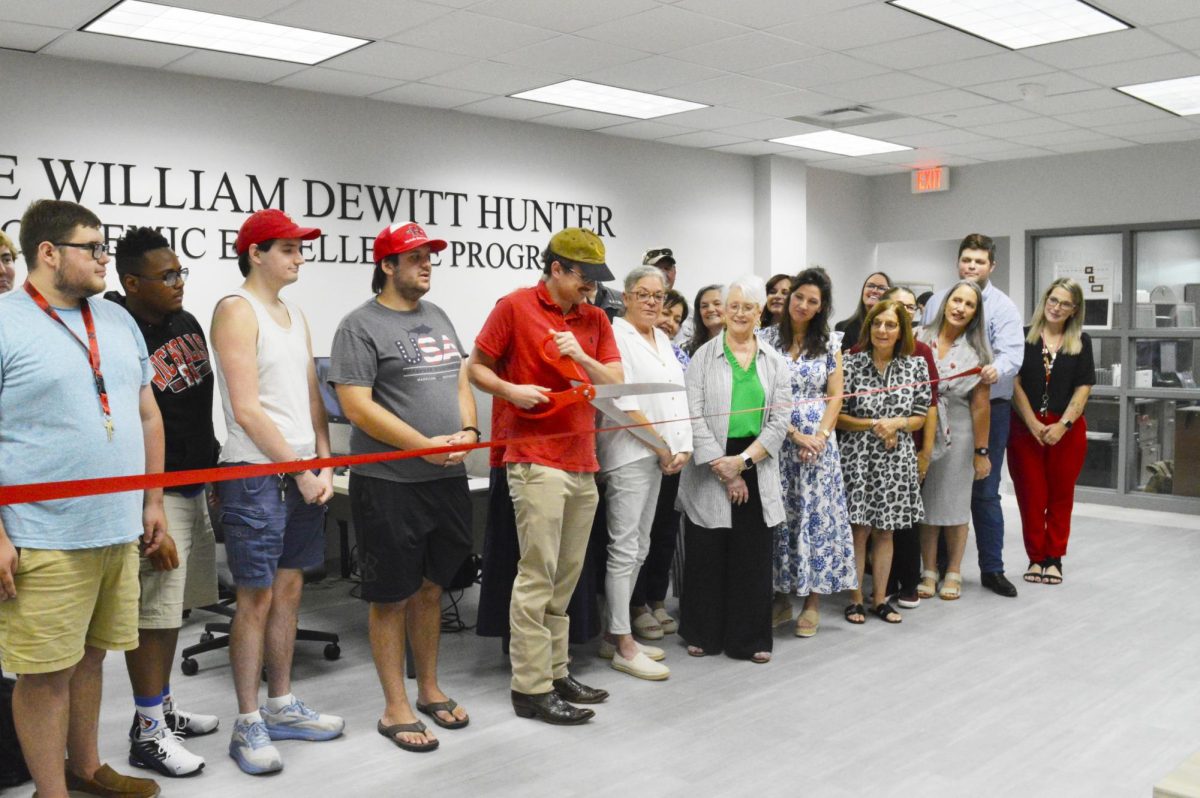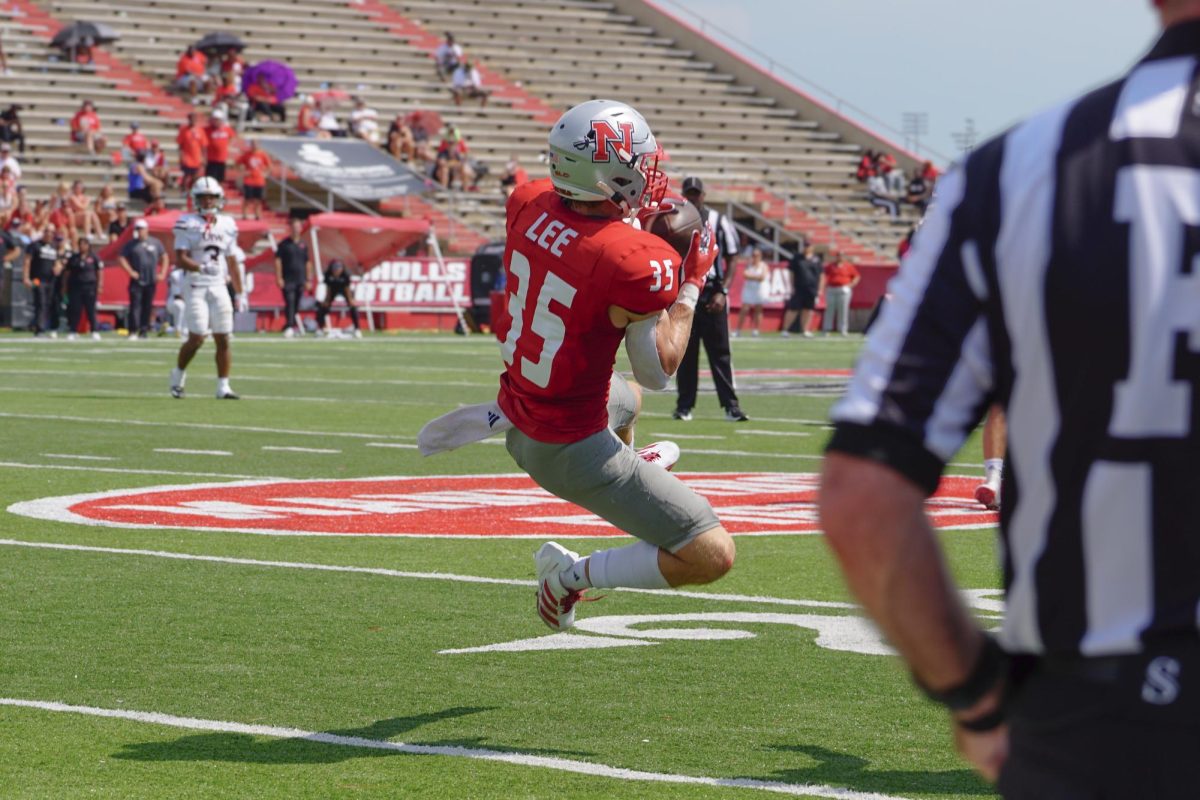Padded black vest, prison stripes and jeans. A murderer, destined to live the rest of his days in prison, bounces unsteadily on the back of a raging bull as it struggles to burst from its tiny chute. The rider’s hands frantically probe for something, anything, to latch onto as the chute is prepped to open. Half a dozen men in the nearby chutes are mirroring his attempts.
As the bulls simultaneously tear into the arena, the crowd erupts into cheers. The inmates desperately grip the bulls and are ultimately flung from the beasts and onto the newly tilled dirt. Some are trampled by the fuming 2,000-pound animals and others run for their lives toward the chute gates.
The crowd continues to cheer as the scene settles and the inmates return to their seats.
This is how things work at Angola only two and a half hours away from Nicholls.
The Louisiana State Penitentiary, more commonly known as Angola, was built on the property of a former plantation, named after the homeland of its slaves. The prison sits in West Feliciana Parish, on the Louisiana state line near the southwest corner of Mississippi.
At one time, Angola was infamous as one of the most violent prisons in the United States, but the images of towering fortress walls and a dull, dark atmosphere can be forgotten. In reality, Angola is a farm prison that covers 18,000 acres of luscious green land.
Driving along the winding levee, signs are posted for livestock crossing, and vast crop rows are dotted along the work camps of this prison known as The Farm. In the 19th century, Louisiana often relied on private contractors to run the penitentiary system. This led to inmates being used for labor.
The prison grounds house more than 5,000 inmates in work camps, many of whom are serving life sentences. The scenery is peaceful, and other than the layers of barbed wire and surrounding towers, the buildings could easily be mistaken for a school.
Today, close to 10,000 people are pouring onto the property to see the spectacle of the Angola Prison Rodeo. The event, which was originally started for inmate and employee amusement, began in 1965. It has grown from its limited public opening in 1967, to a commercial event that supports itself today.
Warden Kenneth Norris speeds down the back roads of Angola while his two-way radio continues to belch the orders and thorough checklists needed to make today a success.
Norris has waves of small wrinkles running down his face from his days on the force, no doubt. His white hair is thinned, but nothing has corrupted his sky-blue eyes.
Norris began working at Angola 12 years ago. “I retired after 32 years with the state police and came to work for Warden Cain,” Norris explains. Originally, Norris worked for the investigative unit at Angola, but now, he is in charge of the hospital, too.
Norris explains that proceeds from the rodeo go to the Louisiana State Penitentiary Inmate Welfare Fund, which pays for inmates’ educational and recreational supplies. The bulk of the money raised will go directly to the inmates.
“The rodeo does not cost the taxpayers any money at all,” Norris insists. “A portion of the money raised goes to the operating expenses, so the state doesn’t pick up any of the costs and the rest goes to the inmates. They make repairs on the rodeo, and buy weight equipment for themselves and things of that nature. The money that they make goes into their accounts so they can send it home to their kids for Christmas and things like that. The bulk of the money goes to the inmates.”
Held one weekend in April and every Sunday in October, the rodeo and hobbycraft sales provide means for low and medium security inmates to possibly earn some extra cash, while enjoying a change of routine.
As many as 1,000 inmates play a role in the festivities. Inmate artists compete to design the rodeo poster every year. Some sell crafts, run concession booths or ride the horses and bulls. Inmate bands also perform before and during the show.
Despite the festive ambiance, visitors are on the grounds of a maximum-security prison. Vehicles and visitors are subject to search and cell phones and cameras are not allowed on the rodeo grounds.
Walking up to the gate, there is the familiar “horse” smell mixed with the sweet, fried scent of concessions. The concessions are prepared by inmates and include things like funnel cakes, seafood and jambalaya.
Just beyond concessions is the hobbycraft area, which is open from 9 a.m. to 6 p.m. Many of the inmates face a life sentence, but that does not deter their creativity. Many are self-taught artists and craftsmen.
“This is to give the inmates something to do,” Norris says. “Give them a mission, and make them part of something. The happier they are, the easier it is to police them. It helps them police themselves, too, because they want to participate. It also gives them something to do when they get off work. They make these hobbycraft items all year long for these two events.”
Row upon row of hobbycraft mimic the lines of crops growing just outside the gate. The inmates spend free time working on the hobbycraft throughout the year specifically for the rodeo. The items for sale rival most typical craft show goods.
Metal work in the form of delicate jewelry with pieces carved and bolted into place to resemble state pride or cartoon characters like Tweety Bird. Leather belts, purses, wallets and keychains. Vivid paintings of swamp scenes and New Orleans nightlife. Religious journeys, including a wooden sculpture titled “Unforgiven” depicting a man writing in his prison cell.
Woodwork, smooth and sanded to a beautiful finish. Some vendors created small items like a scented rose or piggy banks for children. Others built beautiful jewelry boxes, intricate boat models, slender rocking chairs and ornate wardrobes.
Almost every table contains items related to Louisiana, the Saints or LSU.
Many of the inmates stand near their hard work waiting for a sale, sometimes with their family members who get to visit during this special time. Others use sensationalism to shout to passers-by, “I know what you need!” Most are dressed in a white t-shirt, with casual pants.
In a smaller section of the hobbycraft that still spans larger than a gymnasium, medium security inmates stand behind a fence and attempt to heckle customers through the barrier.
“The inmates must have a good record,” Norris explains. “It’s for them to have something to do and enjoy. It’s the trustees, not because they know how to ride or anything, but because they’ve been a model prisoner for the last six months. If they mess up, they can’t come to the next rodeo.”
It is almost time to begin “The Wildest Show in the South!”
An announcer emerges on horseback to warm up the crowd.
SO WHO HERE IS FROM FLORIDA? Some hands raise around the stadium and a few people shout a proud “Ayy” from the audience.
HOW ABOUT MISSISSIPPI? Clumped together on a few rows in the back. They yell, too.
WHAT ABOUT ALABAMA? The gathering is louder this time and a few audience members stand.
WELL, WELCOME TO AMERICA! The audience laughs.
NOW, LET’S SEE, TEXAS? Multiple sections of the audience erupt with shouts.
LOUISIANA? He’s got almost everyone now.
OH YEAH, HOW ABOUT ANY LOVELY OVERSEAS VISITORS? A few handfuls form around the stadium, one from France, another from England, and another for Brazil.
When the rodeo kicks off at 2 p.m., the colors are presented and the inmates form a circle in the arena dirt. They join hands and as the announcer reads a prayer, some fall to their knees and a powerful tenor sings The Star Spangled Banner a cappella in his inmate attire.
The Angola Rough Riders enter the arena at full speed.
It is obvious that a few of the pairs include either
a new rider or a new horse because one or two of the horses fidget underneath unstable passengers. Some riders sport a shaky, but contained, riding stance, while others clutch the saddle tightly. Many of the inmates first mounted a horse as imprisoned men.
The clowns make some corny jokes and the inmates take their positions for the first event. There is no “rehearsal” for these events, and many of the inmates are climbing onto a bull for the first time.
For rodeo events, winning inmates are awarded prizes of about $200 to $300.
First is Bust Out: All chutes open at the same time to release irritated bulls and their temporarily attached cowboys. The last man to remain on the bull wins the event.
Next is Bareback Riding: Inmate riders must stay on the horse, with one hand in the air for eight seconds.
Then, a hula hoop challenge: About eight hula hoops are positioned near a chute in the arena. An inmate must stand in a hula hoop as a bull is released. The last man standing wins.
This event is amusing in particular because it is a game of chicken. Although the announcers warn the inmates to stay completely still in an effort to deter an attack, many cannot contain their fear. One jumped out of his hula hoop before the bull even chose a direction.
Crowd noise never seems to die down. Continuous screaming, whooping and hollering blast from the stands. It feels like a typical rodeo. No different from one that would take place outside the prison walls. Spectators can often forget that the men entertaining them are murderers, rapists, kidnappers and all other kinds of wicked.
Next is Barrel Racing: The only event that inmates do not participate in. Part of The Girl’s Rodeo Association, contestants, as young as four years old, must loop around three singular, carefully placed barrels without knocking one over. The fastest time wins. Two girls fall off their horses during this event. Medics rush toward the contestant who rammed into the fence.
Afterwards, there is a bit with wild horses, where a man cracks his Indiana Jones whip as he corrals them on top of a trailer. Wild horses are also simultaneously released into the arena with short ropes dragging behind them. Teams of three inmates each, attempt to grab and hold the horse long enough for a team member to mount. The first team to cross the finish line with a mounted rider wins.
Then, Bull-Dogging, a 500-pound calf is placed in a chute with two inmates positioned just outside the chute. When the calf comes crashing out, they must wrestle it to the ground as quickly as possible. Most often, the calf wins. Some inmates try to push the calf back and down, which requires too much strength. The best method seems to be both inmates latching on to the calf’s neck and getting on the ground. As the calf’s momentum works for them, they flip it over their heads.
Angola is also known for Convict Poker: “It’s the ultimate poker game, and even winning has a price.” Four inmate cowboys sit at a table in the middle of the arena playing an uneventful game of poker. A wild bull is set loose with the intention of unseating the poker players, with added aggravation from the rodeo clowns. The last man remaining seated is the winner. During one particular poker game, the bull did the picturesque pawing of his hoof in the dirt, and both remaining players leapt from their seats to the safety of the fence.
“I like the card table. That’s my favorite part,” Norris says. “My second favorite part is when the little monkeys ride around on the dogs. They are very cute, but I don’t think they will be here for this show.”
Buddy-Pick-Up: This event requires one man riding bareback on a horse to ride to the opposite side of the arena, pick up a partner inmate who is standing on a barrel, and race back to the finish line. Some riders fell off the horses without the aid of a saddle. Others had the bad luck of stubborn horses that refused to approach the barrel.
Next is Wild Cow Milking: The inmate cowboys must chase the cows, which were milked in the prison dairy earlier in the day, around the arena trying to extract a little milk. The first team to extract milk wins.
Then, the classic Bull Riding: The inexperienced inmates sit on top of a 2,000-pound Brahma bull. The goal is to complete a six-second ride in order to be eligible for the desirable “All-Around Cowboy” title. This event follows the Professional Rodeo Cowboys Association rules.
Finally, Guts & Glory: A poker chip is tied to the forehead of the worst Brahma bull in range. The goal is to get close enough to the bull to snatch the poker chip. The uncooperative bull topples most inmates before they can even approach.
At this rodeo, all of the inmates have at least limped out of the arena, but at most rodeos, injuries accumulate. In the history of the rodeo, there have not been any fatalities, but if a prisoner is injured, he is brought to the Angola hospital.
The crowd flows toward the parking lots as the show ends. Concession trash litters the inmate-built arena. This morning’s freshly tilled dirt has scuffs and prints from where humans and animals wrestled for superiority and amusement. Traffic clogs the dirt road leading to the world with fewer restrictions.
The rodeo has provided a glimpse into a world that centers on seclusion.
It is easy to forget that these inmates, who the audience cheered for, are criminals. Now, they will recede into their normal daily lives. Most of these men will never see another country, state or city.
They’re the inmates of Angola, risking their lives for six seconds of freedom.
Tickets for the rodeo are $15 and can be purchased at www.angolarodeo.com.
Popular prison rodea to return this weekend at Angola
Kami Ellender
•
April 18, 2013
0
More to Discover







